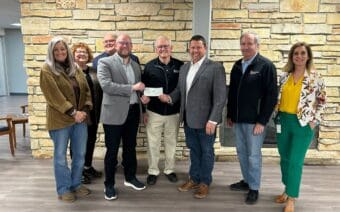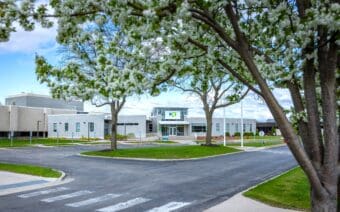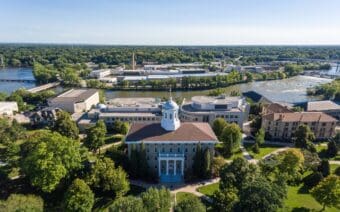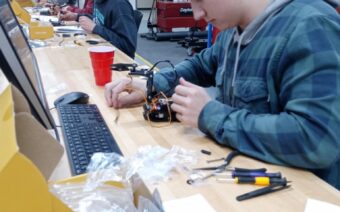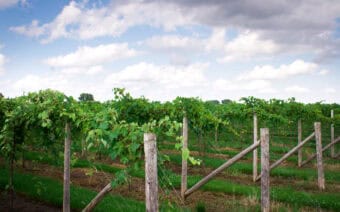
November 29, 2023
GREEN BAY – A recent Northeast Wisconsin Technical College (NWTC) graduate just made history – both in the school and the State of Wisconsin.
Research conducted by Justyna Kakol as a microbiology student at NWTC is now published in a peer-reviewed scientific journal – making her the first undergraduate in the Badger State to do so.
And not just once.
Kakol has now been published three times (“Antimicrobial activity of Paenarthrobacter nicotinovorans,” “Time course study of Paenarthrobacter nicotinovorans secondary metabolite toxicity profile,” “Toxicity of secondary metabolites of Paenarthrobacter nicotinovorans”) in the National Library of Medicine.
For Kakol, the path to having her research published started thousands of miles away in her home country of Poland.
During the COVID-19 pandemic, Kakol said she was deciding where to pursue higher education, a search that eventually led her to NWTC.
“I was always fascinated by science, especially with microbiology,” she said. “I found this program (at NWTC), and the classes were in person, which I liked. I stayed for two years (and) graduated in May (of this year).”
Shortly after starting at the technical college, Kakol said she was introduced to the Tiny Earth program – a global organization that encourages students to make discoveries centered around challenges we face around the world, such as antibiotic resistance.
Angelo Kolokithas, biology program director at NWTC, said the Tiny Earth program works hand-in-hand with NWTC’s Core Undergraduate Research Experience (CURE) and its Laboratory Science Technology program.
“It’s been proven if you involve students in undergraduate research, they have much better, successful outcomes, so we started doing (CURE) in microbiology years back,” he said. “The Laboratory Science Technology program allows students to propose their own research.”
When the time came for her capstone project, Kakol said she decided to focus on the Tiny Earth program and her ongoing research on antibiotic resistance.

Justyna Kakol, a recent microbiology graduate from NWTC, has been published three times in the National Library of Medicine for her study of Paenarthrobacter nicotinovorans. Photo courtesy of NWTC
The researcher said she had no idea her findings throughout her project would reach a national level.
“I thought it was going to be a small project,” she said. “I never thought it would be published.”
Kakol said her research led her to discover that the bacteria she was working with had secondary metabolites – compounds produced by a lifeform that is not directly involved with the growth or development of that specific organism – that had antibiotic activity against pathogens.
To put it simply, Kakol said the bacteria she was working with showed antibiotic effectiveness among different diseases and illnesses.
“When I knew the compounds had antibiotic activity, I wanted to know if it was harmful to humans,” she said. “So, I checked the toxicity in the human HeLa cells (an immortalized cell line used in scientific research), and it turns out it’s not toxic – making the potential for this compound to be a potential antibiotic and treat bacterial diseases.”
The process, challenges
Once Kakol was in her capstone project, Kolokithas said there was less guidance from him, and the majority of the work and research was left in her hands.
“Justyna was thinking on her feet and trying to do things on her own, trying to do all these different techniques,” he said.
Though Kakol took charge on a research project at this intense scale and level, Kolokithas said she was “very good at persevering.”
“I always tell my students, ‘99% of the time, science fails,’” he said. “Everything stops working and then we have to start over again. She kept on chugging at it… Justyna did almost all the work over, and over and over again.”
Kakol said she had help at the beginning of the project from Mainor Vang, who is currently a microbiology student at NWTC.
She said Vang was primarily involved in the initial steps involved in collecting the soil for research.
Vang is listed as a contributor in the three micropublications in the National Library of Medicine as well.
When Kakol and Kolokithas knew the research on Paenarthrobacter nicotinovorans – the bacterium species Kakol was working with – could be monumental, Kolokithas said he felt “comfortable submitting this for publication.”
“Justyna had repeated this so many times,” he said. “By the time we got there, it was like, ‘yes, we are 100% sure of these results now.’”
Kakol said for her, the overall experience throughout the research process was “exciting” and “went pretty well,” but that didn’t mean there weren’t challenges she had to overcome.
“One of (the challenges) was the timeline,” she said. “We couldn’t extend (the time) I wish I had with my project.”
Another challenge, Kakol said, was choosing and changing the bacteria she worked with based on the results she was getting.
“Choosing the techniques I was going to use for isolation of the compounds from the bacteria, that was a challenging process,” she said. “The first trial wasn’t very successful, but we overcame all of the challenges in the project.”
Throughout the entire project, Kolokithas said everything was funded “in house.”
“There was no outside funding for any of this,” he said. “No grants, and we were able to do it from the ground up.”
By the time Kakol graduated from NWTC earlier this year, she said her role in the project was finished and all research was complete.
Though, after graduation, she said she still needed to do some additional work for the publications in the National Library of Medicine.
Next steps
Though she made the discovery she did through her research and has three micropublications in the National Library of Medicine, Kakol said this is “the beginning step.”
“What we discovered is very exciting, and I have a lot of hopes we can extend the research project,” she said. “I checked this antibiotic in human HeLa cells, but there’s a lot of cells we could try… So, I think this project has a lot of potential for more research, and making sure this antibiotic can be used to treat people.”
To propel the project forward, Kolokithas said it would be great to work with the University of Wisconsin-Madison – where Tiny Earth’s headquarters are located – to gain access to more resources to further continue research.
“UW-Madison has more capabilities to start further animal testing and human testing to get to the next steps of (the project),” he said. “The next step, we’re going to start to package it up and send it out to different interested parties (such as UW-Madison) to continue to research. We’ve discovered something and made the first steps of toxicity testing, but of course, we have to do a lot further testing for it to eventually become a viable medication.”
To gain more awareness of the research project, Kolokithas said the Tiny Earth program is having its winter symposium at Lambeau Field Dec. 11, where students will get to showcase their research.
He said the Green Bay Packers have teamed up with Tiny Earth on the event to hopefully attract more community members to learn more about Kakol’s discovery.
“It’s an opportunity and a chance to educate the population of why antibiotic resistance happens and what they can do to stop antibiotic resistance,” he said.
Kolokithas said he also hopes the event diminishes the stigma around undergraduate research and research conducted at a technical college.
“We’re trying to break down barriers of what it means to be a technical college student because there’s a lot of stigma about, ‘well, if you’re going to a tech college, you must not be the best of the best,’” he said. “Being able to showcase we have students who are in their freshman and sophomore years, (and they are) able to do applicable, scientific and world-changing research out of a technical college, I think, is a huge achievement.”
The impact of being published
Much like how Kakol said she never expected her capstone project to lead to publication in a peer-reviewed scientific journal, Kolokithas said in his entire career in science, “I never thought I would publish out of a technical college.”
“It is rare even at the (Universities of Wisconsin) for undergrads to – No. 1 – get involved with research and – No. 2 – to be published with your professors,” he said. “It’s an interesting perspective to (show) we can do this sort of science at a tech college… These are high-caliber students who are going to be successful no matter where they go.”

Angelo Kolokithas, biology program director at NWTC, said not only is this the first piece of undergraduate research to be published at the technical college, but in the state. Photo Courtesy of NWTC
Kolokithas said NWTC hopes to grow and expand with students interested in microbiology research, “because the more people we get coming through these programs, the more ability we have to expose these undergraduate research experiences.”
Kakol said she is excited to have three separate publications in the National Library of Medicine and hopes that her research benefits others.
“Antibiotic resistance is a growing problem,” she said. “So, I’m happy my project can help the community and solve a global problem.”
The now post-undergraduate researcher said the support she received from NWTC was a big help in her Paenarthrobacter nicotinovorans discovery.
“They support the students and their ideas,” she said. “They give students an opportunity to be involved in a research project, and I think it’s amazing that students can learn critical thinking and problem-solving (skills).”
As she looks to her future, Kakol said she would “love to continue my journey with microbiology.”
“I think (being published) is a big success, and most employers, they are looking for someone who has (been published) that has had some success,” she said.
Kakol said she can attest to her own sentiment, as she is now working in the science field as a microbiologist for a company within Northeast Wisconsin.
To learn more about Kakol’s research at Tiny Earth’s winter symposium event, visit tinyearth.wisc.edu.
 New mapping tool shows gaps in broadband coverage
New mapping tool shows gaps in broadband coverage Lamers Dairy takes home two first-place awards at World Dairy Expo
Lamers Dairy takes home two first-place awards at World Dairy Expo


